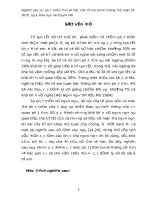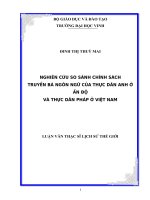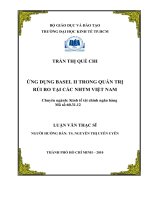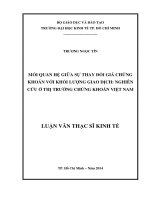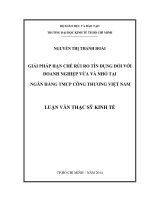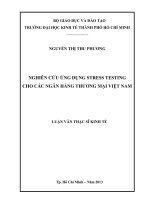Nghiên cứu sự chuyển đổi về ngữ dụng học trong cách nói từ chối của sinh viên Việt Nam (Luận văn thạc sĩ)
Bạn đang xem bản rút gọn của tài liệu. Xem và tải ngay bản đầy đủ của tài liệu tại đây (848.05 KB, 59 trang )
THAI NGUYEN UNIVERSITY
SCHOOL OF FOREIGN LANGUAGES
TRAN THI THUY AN
AN INVESTIGATION ON PRAGMATIC TRANSFER IN
VIETNAMESE EFL REFUSALS
(Nghiên cứu sự chuyển đổi về ngữ dụng học
trong cách nói từ chối của sinh viên Việt Nam)
M.A. THESIS
Field: English Linguistics
Code: 8220201
THAI NGUYEN – 2018
THAI NGUYEN UNIVERSITY
SCHOOL OF FOREIGN LANGUAGES
TRAN THI THUY AN
AN INVESTIGATION ON PRAGMATIC TRANSFER IN
VIETNAMESE EFL REFUSALS
(Nghiên cứu sự chuyển đổi về ngữ dụng học
trong cách nói từ chối của sinh viên Việt Nam)
M.A. THESIS
(APPLICATION ORIENTATION)
Field: English Linguistics
Code: 8220201
Supervisor: Dr. Duong Duc Minh
THAI NGUYEN – 2018
ACKNOWLEDGEMENTS
I would like to express my deep thanks to people who have assisted me when
I carried out the research.
I would like to express my sincere appreciation to my supervisor, Dr. Duong
Duc Minh for his encouragement and guidance throughout the research who gave me
his precious comments, expert advice and most of his kind encouragement during my
doing research.
Also, I would like to acknowledge my gratitude to all of the lecturers and the
staff of the Department of Post-Graduate Studies at School of Foreign Languages,
Thai Nguyen University for their valuable lectures and supports.
I am greatly indebted to my colleagues and students at Thai Nguyen College
of Education, Thai Nguyen School of Foreign Languages, University of Wollongong,
Australia for their enthusiasm, helpfulness, care and patience towards my data
collection which grant great contributions for my thesis.
Finally, I would like to express my special thanks to my parents, my husband
and other members in my family for their love, care, support and encouragement so
that I could accomplish my study.
i
STATEMENT OF AUTHORSHIP
I hereby declare the thesis entitled
An Investigation on Pragmatic Transfer in Vietnamese EFL Refusals
is the result of my own research for the Degree of Master of Arts at the School
of Foreign Languages - Thai Nguyen University and this thesis is in total fulfillment
of the requirements for the Degree Master of Arts. This thesis has not been submitted
for any degree and any other university or institution.
Signed
Date
ii
ABSTRACT
This study is an attempt to investigate similarities and differences in the speech
acts of refusals among native Vietnamese speakers (NVs), Australian native speakers
of English (NEs), and Vietnamese learners of English (VEs). The Written DCT
(Discourse Completion Test) was used for data collection. Research subjects included
90 people in three groups: 30 native Vietnamese speakers, 30 Vietnamese English
learners, and 30 Australian native English speakers. The performance of three groups
were compared to find out the differences in semantic formulae of refusals made by
Vietnamese, Vietnamese English learners and native English speakers, the
characteristics of pragmatic transfer in EFL learners. The responses were coded
according to the classification of refusal strategies as outlined by Beebe et al., (1990).
The findings reveal that pragmatic transfer exists in choice and content of semantic
formulae. Native speakers liked to use more direct refusal strategies and positive
feelings than Vietnamese speakers and the pragmatic transfer occurred in Vietnamese
EFL learners.
iii
LIST OF ABBREVIATIONS
B.A:
Bachelor of Arts
DCT:
Discourse Completion Task
EFL:
English as a Foreign Language
ESL:
English as a Second Language
L1:
First Language
L2:
Second Language
NE:
Native English
NNSs:
Non-native Speakers
NSs:
Native Speakers
NV:
Native Vietnamese
VE:
Vietnamese EFL learners
iv
LIST OF TABLES
Table
Page
Table 3.1: Classification of DCT ..........................................................................19
Table 3.2
The semantic formulas used in the analysis of data (Beebe et
al., 1990 and modified by Phuong, 2014) ...........................................20
Table 4.1: Refusals to a request of higher status person ......................................23
Table 4.2: Examples of semantic formula ............................................................24
Table 4.3: Refusals to a request of lower status person........................................25
Table 4.4: Examples of semantic formula ............................................................25
Table 4.5: Refusals to an invitation of higher status person .................................26
Table 4.6: Examples of semantic formula ............................................................26
Table 4.7: Refusals to an invitation of lower status person ..................................27
Table 4.8: Examples of semantic formula ............................................................27
Table 4.9: Refusals to an offer of a higher status person .....................................28
Table 4.10: Examples of semantic formula ............................................................28
Table 4.11: Refusals to an offer of a lower status person.......................................29
Table 4.12: Examples of semantic formula ............................................................29
Table 4.13: Refusals to a suggestion of a higher status person ..............................30
Table 4.14: Examples of semantic formula ............................................................30
Table 4.15: Refusals to a suggestion of a lower status person ...............................31
Table 4.16: Examples of semantic formula ............................................................31
v
TABLE OF CONTENTS
Page
ACKNOWLEDGEMENTS ................................................................................ i
STATEMENT OF AUTHORSHIP ................................................................... ii
ABSTRACT ...................................................................................................... iii
LIST OF ABBREVIATIONS ........................................................................... iv
LIST OF TABLES ............................................................................................. v
TABLE OF CONTENTS .................................................................................. vi
CHAPTER I: INTRODUCTION ................................................................... 1
1.1. Rationale for the study.......................................................................... 1
1.2. Aims of the study.................................................................................. 2
1.3. Research Questions............................................................................... 2
1.4. Significance of the study ...................................................................... 2
1.5. Scope of the study................................................................................. 2
1.6. Outline of the study .............................................................................. 3
CHAPTER II: LITERATURE REVIEW...................................................... 4
2.1. Pragmatic Transfer ............................................................................... 4
2.2 Factors affecting pragmatic transfer ...................................................... 5
2.3 Speech Acts ........................................................................................... 6
2.4 Refusal as a Speech Act ........................................................................ 8
2.5 Classification of Speech Acts ................................................................ 9
2.6 Studies on the Speech Act of Refusals ................................................ 12
CHAPTER III: METHODOLOGY ............................................................. 17
3.1. Research approach .............................................................................. 17
3.2. Subjects of the study ........................................................................... 17
3.3. Instrument ........................................................................................... 17
3.4. Data collection procedure and analysis .............................................. 19
3.4.1 Data collection procedure ................................................................. 20
3.4.2 Data Analysis .................................................................................... 20
CHAPTER IV: FINDINGS AND DISCUSSION ........................................ 22
4.1 Refusals to requests ............................................................................. 23
vi
4.1.1 Refusal to a request of salary payment (higher) ............................... 23
4.1.2 Refusal to a request of staying late (lower) ...................................... 25
4.2 Refusals to invitations ......................................................................... 26
4.2.1 Refusal to an invitation to a restaurant (higher) ............................... 26
4.2.2 Refusal to an invitation to a boss party (lower) ................................ 27
4.3 Refusals to offers ................................................................................. 28
4.3.1 Refusal to an offer to pay for a vase (higher) ................................... 28
4.3.2. Refusal to an offer to an executive promotion (lower) .................. 29
4.4 Refusals to suggestions ........................................................................ 30
4.4.1 Refusal to a suggestion to have more conversation in Foreign
Language (higher) ........................................................................... 30
4.4.2. Refusal to a suggestion to write a reminder (lower) ...................... 31
4.5. Choice of semantic formulae used in refusals of Vietnamese EFL
learners ....................................................................................................... 32
4.5.1 ‘Explanation’ .................................................................................... 32
4.5.2. “Gratitude’ ....................................................................................... 33
4.5.3. Positive feeling & Regret ................................................................ 33
4.5.4. Direct ‘No’ ....................................................................................... 34
4.5.5 Social Status ..................................................................................... 35
4.5.6 Social Distance ................................................................................. 35
CHAPTER V: CONCLUSIONS ................................................................... 37
5.1 Semantic formulae for the speech act of refusals used by native speakers
of Vietnamese, Native English and Vietnamese EFL learners ............. 37
5.2 Pragmatic transfer in the semantic formulae used in refusals of
Vietnamese EFL learners................................................................... 38
5.3 Implications ......................................................................................... 38
5.4 Limitations ........................................................................................... 39
5.5 Recommendations for Future Studies ................................................. 39
REFERENCES ............................................................................................... 41
APPENDIX ..................................................................................................... 45
vii
CHAPTER I: INTRODUCTION
1.1. Rationale for the study
Language is the carrier of culture and culture the substance of language: The two
cannot exist separately (Romaine, 2000). To succeed in communicating with others, one
must be aware of the culture behind the language used in communication (Tanck, 2004).
When speaking a foreign language, the issue of culture becomes critical. English as
Foreign language (EFL) learners, especially those with languages different and distant
from English psychologically, culturally, phonologically, and syntactically, may struggle
when attempting to communicate in English. Non-proficient language learners are not
only jeopardized by their imperfect language knowledge but obstructed by their
inadequate knowledge of culture.
To compensate for their lack of knowledge, EFL learners may fall back on
their own linguistic cultural reservoir, translating utterances from their mother tongue
and applying their own cultural rules when communicating in English (Al-Eryani,
2007; Lauper, 1997). This might lead to pragmatic errors that could result in
misunderstanding and embarrassment or pragma-linguistic failure (Riley, 1989;
Thomas, 1983; Umale, 2011).
This is especially important nowadays as “cross-cultural communication is
becoming an integral part of life, with globalization and rapid advances in new
technology” (Umale, 2011, p. 19). In addition, employment opportunities in the local
and global market increasingly demand good language proficiency and
communicative ability. Therefore, teaching pragmatic rules in a way that they would
involve communication strategies and speech acts will give students the English
knowledge and communicative competence that will secure good job placements
after graduation.
The phenomenon of pragmatic transfer and their motivating factors have been
investigated in several speech acts in different languages, such as English, Hebrew,
Spanish, French, German, Danish, Arabic and Portuguese (Byon, 2004). Several
cross-cultural studies proved that pragmatic transfer is evident in L2 speech
1
performance. As for Asian languages, except for Japanese, the number of ILP studies
is limited. To this date, there has been no single attempt to study pragmatic transfer
in Vietnamese speech acts of refusal. To this date, there has been no single attempt
to study pragmatic transfer in Thai Nguyen university students’ speech acts of refusal.
1.2. Aims of the study
The present study aims to investigate the semantic formulae for the speech act of
refusal by native speakers of Vietnamese, native English and Vietnamese EFL learners
then explore whether the pragmatic transfer exist in the semantic formulae of Vietnamese
English language learners. Taking the refusal speech act as a case in point, it sought to
discover how Vietnamese EFL university students used English when refusing requests,
invitations, offers, and suggestions presented to them in a set of scenarios. The study
examines whether the responses appropriate pragmatically and accurate linguistically
and the factors that could have influence them.
1.3. Research Questions
1. What are the semantic formulae for the speech act of refusals used by native
speakers of Vietnamese, native English and Vietnamese EFL learners?
2. To what extent does pragmatic transfer exist in the semantic formulae used in
refusals of Vietnamese EFL learners?
1.4. Significance of the study
Many cross-cultural refusal studies have a methodological problem, in that
they are focused mainly on oral interactions, even though data were often collected
via written surveys. In addition, no attention, as far as I can find, has been given to
refusals within mountainous students who are studying EFL. Therefore, it is
important to investigate refusal patterns when learning English of these students,
especially in Thai Nguyen University.
1.5. Scope of the study
This study will only focus on investigating the pragmatic transfer used in
refusals of students Thai Nguyen University. The native Vietnamese students will
come from College of Education, native English students will come from University
2
of Wollongong, Australia and non-native EFL students will come from School of
Foreign Languages – Thai Nguyen University.
1.6. Outline of the study
This paper’s contents were arranged in an order which reveals information
from theoretical to empirical.
Chapter I: INTRODUCTION, gives an overview of the study. More
particularly, it includes statement of the problem, the main reasons leading to this
research, intentional aims, objectives as well as brief description of scope and
significance, methods, and design of the inquiry.
Chapter II: LITERATURE REVIEW, clarifies theoretical background and
related preceding studies relevant for the research. Both positive impacts and
disadvantages will be exposed in this section.
Chapter III: RESEARCH METHODOLOGY, focuses on eliciting
research questions, research methods, data collection procedure and data analysis.
Chapter IV: FINDINGS AND DISCUSSION, helps to examine the
semantic formulae for the speech act of refusals used by native speakers of
Vietnamese, native English and Vietnamese EFL learners then find out the pragmatic
transfer which exist in the semantic formulae used in refusals of Vietnamese EFL
learners.
Chapter V: CONCLUSION, briefly summaries the main points of the paper,
provides essential findings, displays existing limitations together with implications
and gives suggestions for further studies.
Finally, REFERENCES and APPENDICES are also listed sufficiently at the
end of the research.
3
CHAPTER II: LITERATURE REVIEW
2.1. Pragmatic Transfer
Defining pragmatic transfer is not any easier because of researchers’
disagreement about how to define the scope of pragmatics. According to Olshtain and
Cohen (1989), pragmatic transfer refer to L2 learners’ strategy of incorporating
native-language-based elements in L2 production. The proposed definitions reflect
the problem. According to Wolfson, “the use of rules of speaking from one's own
native speech community when interacting with members of the host community or
simply when speaking or writing in a second language is known as sociolinguistic or
pragmatic transfer” (1989, p. 141). Since then, pragmatic transfer in EFL has received
considerable attention and becomes an important source of cross-cultural
communication breakdown (e.g. Beebe, Takahashi, & Uliss-Weltz, 1990). A good
example of pragmalinguistic transfer is provided by Takahashi and DuFon’s (1989)
study which examined nine Japanese English ESL learners’ use of indirectness in two
request situations. They found that the L2 learners at beginning proficiency level were
either too direct or too indirect in their choice of indirectness in one of the situations.
Byon (2004) also identified and described socio-pragmatic features of Americans
learning Korean as a foreign language in the Korean communicative act of requests.
The semantic formulae usage patterns of the learners of Korean as a foreign language
were consistent with those of the American ENSs, indicative of an L1 transfer effect.
Regarding pragmatic transferability, Takahashi (1993, 1996) maintains that if
L1 strategy is perceived to be frequently used and assumed to be appropriate enough,
this strategy would more likely be transferred to the L2 context. Her second
transferability criteria, that is equivalence of strategies in L1 and L2, is perceived the
equivalent of the L1 and L2 pair of a request strategy in terms of contextual
appropriateness. Based on the two above criteria, she proposed a pragmatic
transferability scale, which posits that strategies rated high for contextual
appropriateness and viewed as contextual equivalents are more transferable, whereas
4
those that are rated low for appropriateness and considered contextually different are
less transferable.
2.2 Factors affecting pragmatic transfer
Occurrences of pragmatic transfer may be influenced by various factors
including L2 learners’ perception of language distance between their L1 and L2 (e.g.
Takahashi, 1996), learning context (e.g. Takahashi & Beebe, 1987), instructional
effect (e.g. Bardovi-Harlig, 2001; Kasper, 1982), L2 proficiency (e.g. Olshtain &
Cohen, 1989; Takahashi & Beebe, 1987), and length of time in the L2 community
(e.g., Félix-Bradsefer, 2004). The study by Robinson (1992) suggests that L2 learners
may be more prone to transfer their pragmatic L1 knowledge when they hold a
universalist view. More specifically, these studies demonstrated that L2 learners may
not transfer L1 pragmatic features to the L2 if they perceive them as language
specific.
Recently, Phan (2001) listed twelve socio-cultural factors that, in his point of
view, may affect the choice of directness and indirectness in communication:
1. Age: the old tend to be more indirect than the young.
2. Sex: females prefer indirect expression.
3. Residence: the rural population tends to use more indirectness than the urban.
4. Mood: while angry, people tend to use more indirectness.
5. Occupation: those who study social sciences tend to use more indirectness
than those who study natural sciences.
6. Personality: the extroverted tend to use more directness than the introverted.
7. Topic: while referring to a sensitive topic, a taboo, people usually prefer
indirectness.
8. Place: when at home, people tend to use more directness than when they are
elsewhere.
9. Communicative environment/setting: when in an informal climate, people
tend to express themselves in a direct way.
10. Social distance: those who have closer relations tend to talk in a more
direct way.
11. Time pressure: when in a hurry, people are likely to use direct expressions.
5
12. Position: when in a superior position, people tend to use more directness
to their inferiors. These factors help to determine the strategies used when speakers
perform the act of refusing
The present study was intended to address the issue of pragmatic
transferability by examining the transferability of English refusal strategies when
Vietnamese learners of English realize English refusals in corresponding L2
contexts.
2.3 Speech Acts
The concept of speech acts was first developed by Austin (1962), and defined
as a set of utterances by which people perform a specific function such as apologizing,
complaining, requesting, refusing, complimenting, or thanking. Austin (1962)
identified three different features of speech acts: (i) locutionary, (ii) illocutionary,
and (iii) perlocutionary acts. Locutionary act refers to a literal meaning of an
utterance; illocutionary act refers to an intended meaning of an utterance; and
perlocutionary act is the actual effect by saying something. For example, one
performs a locutionary act when s/he describes the thermal condition of a room by
saying it is hot here. In this description, the thermal condition of the room is given by
the word hot and the room itself is referred to by the word here. However, if one says
the same thing expecting some actions to be taken such as opening a window or
turning on an air-conditioning unit to lower the room temperature, then s/he is
performing an illocutionary act. The opening of the window or turning on the airconditioning then is the effect of the utterance, which is a perlocutionary act.
Vaezi (2011) also defined speech act as a functional unit in communication.
It is an act that speakers implement when making utterances. All languages have
almost unique ways of performing speech acts. Although speech acts are universals,
the method used in performing speech acts is dissimilar in different cultures (Vaezi,
2011).
To put it more succinctly, a speech act is an action performed by an utterance
(Belza, 2008; Bruti, 2006). The utterance usually carries an attitude, and this attitude
6
corresponds to the speech act being performed (Bach, 2007). The listener’s
understanding of the attitude leads to understanding the speech act.
Since the intended meaning of speech acts or illocutionary acts is a vital
component of speech acts, Austin (1962) presented a classification of illocutionary
acts based on the function of the verbs used. However, because of “the ungrounded
nature, unclarity, and overlap of these classes” several researchers have proposed
different taxonomies of illocutionary acts (Horn & Ward, 2004, p. 64). For example,
Searle (1976) proposed five classifications for illocutionary acts, which are defined
in the following manner.
• Representatives (or Assertives) are speech acts in which a speaker commits
to the truth of the expressed statements (e.g., describing something).
• Commissives are speech acts in which a speaker commits some future actions
(e.g., promising, guaranteeing, and swearing).
• Directives are speech acts in which a speaker requests the hearer to perform
a particular action (e.g., commanding, requesting).
• Expressives are speech acts in which a speaker expresses his/her feelings
(e.g., thanking, apologizing, welcoming).
• Declarations are speech acts that change the reality in accord with the
proposition of the declaration (e.g., nominating, resigning).
Speech acts can also be realized directly or indirectly, but they are frequently
carried out indirectly in our everyday lives to soften the force of the act (LoCastro,
2012). When a speech act is performed indirectly and thus the linguistic form does
not explicitly represent the speaker’s actual intention, an addressee needs to infer
the intended meaning of the speaker’s utterance. Understanding of the speaker’s
actual intention requires the addressee to consider the meaning of the utterance in a
particular context. Furthermore, in order to appropriately respond, the addressee
also needs to know the appropriate practices of speech acts in a given speech
community.
Examples of speech acts include requesting, offering, apologizing,
complimenting, congratulating, sympathizing, and refusing, all of which are
7
language-based actions. Because the present study focuses on refusals as produced
by native speakers of Vietnamese, Vietnamese EFL speakers and native speakers, the
following section reviews the literature on this particular speech act.
2.4 Refusal as a Speech Act
Refusal is a “face-threatening act that tends to disrupt harmony in
relationships” (Umale, 2011, p. 18). Due to its sensitivity, a refusal can be perceived
differently between speaker and listener. It is a negative response to another speech
act issued in the form of a request, invitation, or suggestion (Abdul Sattar, Che Lah,
& Suleiman, 2011). Due to the nature, refusals can affect people’s relationships
adversely if perceived as impolite or uncaring. According to Umale (2011), refusals
may damage the positive face of the speaker and threaten the negative face of the
listener. Therefore, the author continues to “mitigate threats to face” caused by
refusals, speakers can use politeness strategies (p. 19).
Among recent studies that have been carried out on the refusal speech act,
Beebe, Takahashi and Uliss-Weltz (1990) found that Japanese refuse differently
according to the status of interlocutors, while Americans are more affected by the
degree of familiarity or the social distance between interlocutors. Japanese display a
different frequency of semantic formulae between higher and lower status requesters,
while Americans do not. These studies are cross-cultural – in other words,
comparative-cultural – rather than intercultural.
Gass & Houck (1999) also defined refusals as speech acts that occur as
negative responses to other acts such as requests, invitations, offers, and suggestions.
While some researchers view refusals as Commissive speech acts (e.g., FélixBrasdefer, 2004; García, 2007), refusals may not always fall into this category as they
are not always rejections and sometimes involve negotiation in which the participants
do not even know what the final outcome will be. In addition, Farnia and Wu (2012)
investigated the refusals to invitation by use of a written discourse completion test
and an immediate structured interview aimed to examine their perception concerning
their cognition and language of thought in the process of refusing. The findings
showed that both groups used similar types of refusal strategies, but they differed in
8
the frequency of the refusals. In addition, the most frequent refusal strategies were
found to be statements of regret, excuses, reasons and explanation and expression of
negative ability and willingness.
2.5 Classification of Speech Acts
Austin (1975) establishes five categories of speech act based on broad classes
of illocutionary force. They are as follows. Verdictives are acts in which a verdict or
appraisal is given, usually by someone in a position of power to give that appraisal.
Exercitives involve the exercise “of powers, rights, or influence.” Austin’s examples
of exercitives include “appointing…urging… warning” Commissives commit the
speaker to an action or intention; they include promises as well as mental
commitments like taking one side of an argument (Austin, 1975).
The last two of Austin’s categories are broader than the first three, and defined
in a vague way that Austin acknowledges as problematic. Behabitives have to do with
social behavior, including “apologizing, congratulating, commending, condoling,
cursing, and challenging.” Austin acknowledges the broad scope of this category, but
moves on to describing the even vaguer expositives, which he defines as “making plain
how our utterances fit into the course of an argument or conversation, how we are
using words, or, in general, are expository”. Examples are ‘I reply’, ‘I argue’, ‘I
concede’, ‘I illustrate’, ‘I assume’, ‘I postulate’” (Austin, 1975).
Searle (1976) challenges Austin’s taxonomy on the basis of the categories that
Austin himself admits are problematic. Searle establishes a set of features that vary
across speech acts and creates a taxonomy of speech acts based on variation in these
features. Searle lists twelve of these features, which he calls “dimensions of
variation”, but the following three are most significant for his purposes. First is
illocutionary point, the purpose of a speech act. Searle illustrates illocutionary point
by comparing requests with commands: while they are different speech acts with
different amounts of force behind them, they share the purpose of getting the
addressee to do something. Second is direction of fit: whether the words comprising
the speech act are intended to match the world, as in assertions and descriptions, or
the world is intended to match the words of the speech act, as in promises and
9
requests. Searle’s example of world-to-word fit is a shopping list used by a man
in a grocery store; his example of word-to-world fit is a detective following the
shopper around the store and writing down everything he buys. Third is expressed
psychological state, which is less precise but can still be generalized across classes of
speech act. If a speech act contains propositional content, the act must also express
the speaker’s attitude toward that content (Searle, 1976). Although Searle’s taxonomy
is superior to Austin’s in that it begins with a strict set of organizational principles
and holds to them. However, the application of these principles to his categories is
not without fault.
This study assumes that there is the possibility that the norms of the L2
might turn to be at work when using one’s L1 in producing different speech
acts. Therefore, Beebe et al. (1990, as cited in Farnia & Wu, 2012, p. 174)
classification which offers the refusal strategies, consisting of Direct Refusals,
Indirect Refusals and Adjuncts to Refusals seems suitable to this study as follows:
1. Direct
A. Performative (e.g., “I refuse”)
B. Nonperformative statement
1. “No”
2. Negative willingness/ability (e.g., “I can’t.” “I won’t.” “I don’t think
so.”)
2. Indirect
A. Statement of regret (e.g., “I’m sorry ...”; “I feel terrible ...”)
B. Wish (e.g., “I wish I could help you ...”)
C. Excuse, reason, explanation (e.g., “My children will be home that night.”;
“I have a headache.”)
D. Statement of alternative
1. I can do X instead of Y (e.g., “I’d rather ...”; “I’d prefer ...”)
2. Why don’t you do X instead of Y (e.g., “If you had asked me earlier,
I would have ...”)
E. Set condition for future or past acceptance (e.g., “If you had asked me
earlier, I would have ...”)
10
F. Promise of future acceptance (e.g., “I’ll do it next time”; “I promise I’ll ...”
or “Next time I’ll ...” -- using “will” of promise or “promise”)
G. Statement of principle (e.g., “I never do business with friends.”)
H. Statement of philosophy (e.g., “One can’t be too careful.”)
I. Attempt to dissuade interlocutor
1. Threat or statement of negative consequences to the requester (e.g.,
“I won’t be any fun tonight” to refuse an invitation)
2. Guilt trip (e.g. waitress to customers who want to sit a while: “I can’t
make a living of people who just order coffee.”)
3. Criticize the request/requester, etc. (statement of negative feeling or
opinion); insult/attack (e.g. “Who do you think you are?; That’s a
terrible idea!”)
4. Request for help, empathy, and assistance by dropping or holding the
request.
5. Let interlocutor off the hook (e.g. “Don’t worry about it.” “That’s
okay.” “You don’t have to.”)
6. Self-defense (e.g. “I’m trying my best.” “I’m doing all I can do.” “I
no do nutting wrong.”)
J. Acceptance that functions as a refusal
1. Unspecific or indefinite reply
2. Lack of enthusiasm
K. Avoidance
1. Nonverbal (a. Silence, b. Hesitation, c. Doing nothing, d. Physical
departure)
2. Verbal (a. Topic switch, b. Joke, c. Repetition of part of request etc.
(e.g., “Monday?”), d. Postponement (e.g., “I’ll think about it.”), e.
Hedging (e.g., “Gee, I don’t know.” “I'm not sure.”)
Adjuncts to Refusals
11
Adj1. Statement of positive opinion/feeling or agreement (e.g. “That’s a good idea...”
“I’d love to...”)
Adj2. Statement of empathy (e.g. “I realize you are in a difficult situation.”)
Adj3. Pause fillers (e.g. “uhh”; “well”; “oh”; “uhm”)
Adj4. Statement of gratitude or appreciation (e.g. “thanks”; “I really appreciate it”).
2.6 Studies on the Speech Act of Refusals
The cross-cultural studies reveal the difference between the same acts in a
variety of cultures. These studies allow for identifying potential pragmatic failures
committed by non-native speakers and finding ways to teach pragmatics that would
prevent these failures. Beebe, Takahashi and UlissWeltz’s (1990) groundbreaking
work in cross-cultural studies of refusals has contributed to the development of the
methodology and the taxonomy that are frequently utilized in other studies.
In their taxonomy, refusal strategies fall into two broad categories: Semantic
formulas and Adjuncts. A semantic formula, or a strategy, is a set of expressions,
which could be a word(s), a phrase(s) or a sentence(s), and can function as a refusal.
An adjunct is a set of expressions that supplement a refusal, but by itself cannot
function as a refusal. Semantic formulas are further divided into direct and indirect
realization of refusals.
Among those studies focusing on the refusals of L2 learners, some examined
how the L1 sociocultural norm has affected the L2 learner’s refusal performance, i.e.,
pragmatic transfer. Beebe et al. (1990) found that Japanese learners of English
resemble native speakers of Japanese, and differ from native speakers of English in
their refusals, indicating the existence of pragmatic transfer phenomenon. While
Japanese were more affected by the status of the interlocutors, Americans refused
differently according to the degree of familiarity with the interlocutors. With regard
to the content of semantic formulas, the researchers found that the excuses the
American-English group used tended to be more specific than those of the JapaneseJapanese and Japanese-English groups. Similar tendencies were found by Beebe and
Cummings (1985, 1996).
12
Beckers (1999) compared German and American refusals and concluded that
German refusals are less direct than American refusals. In another study, Nelson, Al
Batal and El Bakary (2002) used DCT with 25 Egyptians and 30 Americans but in a
spoken form in their home countries and in the participant’s native language. They
concluded that the frequencies of the direct and indirect refusal strategies are almost
equal. Kwon (2004) compared English and Korean refusals in their native languages
and found that Americans do not take into account status as much as the Koreans did.
In addition, while Koreans have a tendency to give reasons, Americans do not favor
that.
Felix-Brasdefer (2003) investigated the speech act performance of native
speakers of Mexican Spanish, native speakers of American English, and advanced
learners of Spanish as a foreign language in refusals in six different situations (two
invitations, two requests, and two suggestions) of equal and high status using
enhanced role plays and retrospective verbal reports. Results show that learners
differed from the native groups in the frequency, content, and perceptions of refusal
strategies. Among the learners, negative pragmatic transfer was found in the
frequency, content, and social perceptions of refusal strategies.
A study of socio-cultural transfer and its motivating factors within the
realization patterns of the speech act of refusals by Jordanian EFL learners was
carried out by Al Issa (2003). EFL refusal data were collected using a Discourse
Completion Task (DCT). The DCT was then followed by semi-structured interviews.
Using semantic formulae as units of analysis, EFL refusal responses were compared
with similar data elicited from native speakers of English responding in English and
native speakers of Arabic responding in Arabic. The results showed that sociocultural transfer influenced the EFL learners’ selection of semantic formulae, the
length of their responses, and the content of the semantic formulae. The cases of
transfer were seen to reflect cultural values transferred from Arabic to English.
The culture of Vietnam is greatly influenced by Chinese culture, French
civilization, Buddhist philosophy, Christianity and Communism, as well as the
ongoing globalization process (Dao 2000; Tran 1998; Jamieson 1991). However,
13
traditional Vietnamese culture is still preserved while accumulating and localizing
foreign cultural influences (Ngo 2001; Tran 1998).
Vietnamese society is no longer as agriculturally dominated as it once was (Do
2002). It has become industrialized and is subject to increasing globalization. A large
percentage of the population has to conform to the norms and patterns of industrial
life, with changing lifestyles and ways of thinking. in the Vietnamese culture, when
asking such questions as “Are you married ?”, “How old are you ?”, “How much do
you earn a month?”, people simply want to show their concern for others, with no
motive other than facilitating and making the distance between communicators closer
and friendlier, thus enhancing solidarity. These questions, on the other hand, are
considered intrusive to privacy in non-Confucian societies. Marital status, age,
income, and religion are matters that people usually refrain from discussing when
they are engaged in everyday social conversation, especially with someone that they
do not know well enough.
With regard to politeness strategies in refusals, according to Phuong (2006),
Vietnamese have some social norms that require conversants to be able to refuse
in a polite manner. This fact has modified the thinking and behaviours of VEs.
Some have successfully become very fluent in English. Nonetheless, when
resorting to different ways of refusing, they tend to be more indirect than their
English-speaking counterparts. This study aims to explore this pragmatic transfer
in English language refusals.
Research on the Vietnamese speech act of refusal specifically restricted to
directness/indirectness, includes a study on some cross-cultural differences in
refusing a request in English and in Vietnamese (Phan, 2001). She found out that both
Anglophone and Vietnamese informants tend to use more indirect refusals than direct
ones. Comparing the degree of directness and indirectness of refusals by Anglophone
and Vietnamese informants, all the Anglophone informants are more direct than the
Vietnamese ones. She made some comparisons and drew some similarities and
differences between the two groups. The following are some similarities and
differences. Similarities: - Both Anglophone and Vietnamese informants tend to use
14
more indirect refusals than direct ones. In both Anglophone and Vietnamese cultures,
city dwellers are more direct than rural people. Rural people, especially Vietnamese,
always exceed the urbanites in the degree of indirectness. Informants who do not
know any foreign languages are less direct and more indirect than those with
knowledge of some foreign languages. Differences show comparing the degree of
directness and indirectness of refusals extended by Anglophone and Vietnamese
informants, all the Anglophone informants are more direct than the Vietnamese ones.
All groups of Vietnamese informants are substantially more indirect than their
Anglophone partners.
Recently, Phuong (2006) conducted a research to investigate the refusals of
request by Australian native speakers of English and Vietnamese learners of English
from cross-cultural pragmatics perspectives. She found that refusals of AEs are
different from those of VEs, though they do share some similarities. Parallel to the
differences in culture, AEs and VEs also differ in the ways they say “NO” to their
conversational partners. VEs are apt to express refusals with caution and/or care. VEs
used more statements of regret, more statements of sympathy, more adjuncts to
refusals addressing term and more reasons/excuses/explanations in their refusals. In
addition, the excuses/reasons/explanations given by AEs are more related to their
readiness to reveal their disinclinations to comply in contrast to VEs. AEs are more
direct in the ways they refuse: AEs employed more “NO” phrases, more statements
of principles, and more statements of unwillingness/doubt than VEs.
AEs and VEs show the same number of SARs when they communicate with
people of the three social statuses and social distances, but VEs are more sensitive to
the social statuses and social distances of the requesters. The gender of conversational
partners is relevant: both AEs and VEs used more statements of regret when they
refused people of opposite gender than of the same gender: opposite-gender refusals
require more elaboration and more care.
In sum, although the literature on refusals is abundant, most studies, as
mentioned before, have been conducted between English and languages
such as Japanese, Chinese, Korean, and so on. As far as the present researcher’s
15
smattering knowledge is concerned, however, no systematic study has been done to
compare the speech act of refusals between English and Vietnamese. Therefore, the
researcher intended to hopefully fill this gap in the literature.
16
